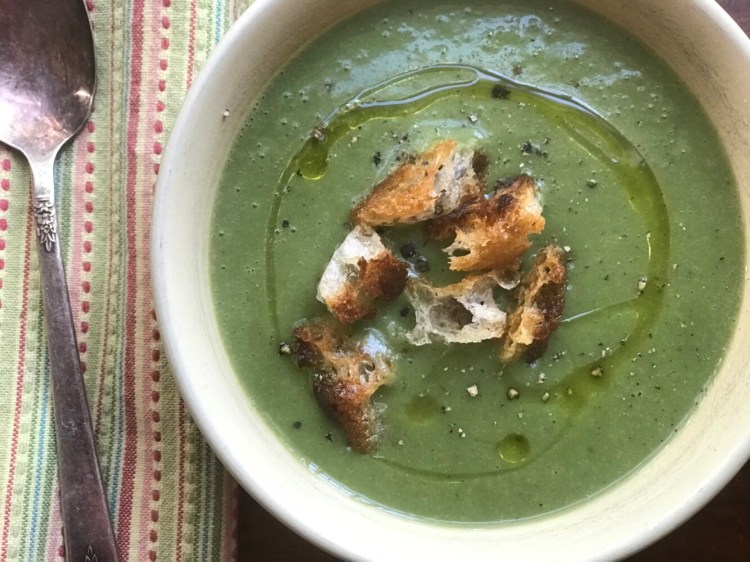As a kid, I didn’t care for see-through soups of all kinds. But I absolutely loathed the turkey soup that followed Thanksgiving. I didn’t mind the broth, and the rice or pasta in the pot was perfectly fine if it hadn’t sat too long in there, soaking up the liquid. But I could not stomach the floaties – mushy onion bits, slimy celery slices, and soggy stuffing chunks simmered off the inside of the carcass. They floated in the soup, staring up at me from their buoyant perch, taunting me. As I had been taught to eat what was put in front of me, I learned to pick around them, leaving them stranded at the bottom of the bowl, wasted.
As an adult, I regularly dip into any number of Asian noodle soups – like Chinese egg drop, Japanese ramen, Thai tom kha gai and Vietnamese pho – so I can’t say I still eschew clear soups entirely. But I largely remain a creamy, blended soup kind of gal.
My first full-time journalism job, in 1990, at a small Western Massachusetts weekly newspaper, paid $1,000/month. I waited tables at a French bistro called La Tomate in Great Barrington to help cover my rent and a loan payment for my tiny, cherry red Ford Festiva, also called La Tomate. Four nights a week, I happily ate in La Tomate, the restaurant, not the car.
Provence-born Chef Jean Claude Vierne consistently offered a potage, both on the menu and at the nightly staff meal. A word that in both French and English originally meant whatever was in the pot, “potage” nowadays denotes a thick soup. Chef Vierne, who had worked in restaurants from Paris’s Le Coupe-Chou to New York’s La Caravelle, changed the flavor of his potage daily. But at the core of any soup of the day at La Tomate were potatoes and alliums. The variety came from seasonal herbs and vegetables that didn’t quite meet the chef’s picture-perfect standards required for a spot on the dinner plate. When simmered slowly together in house-made veal or chicken stock and pureed (yes, that means no floaties!) until silky smooth, the results certainly made high marks. These soups rarely called for heavy cream, but their smooth, satisfying mouthfeel made it seem as though they had. A bowl of Jean Claude’s potage topped with cheesy croutons made from yesterday’s bread continually carried me through many a harried dinnertime service in which we turned the tables three and four times on a busy night.
The base of the potage was always 2 pounds of potatoes and 2 cups of chopped onions or leeks simmered in 10 cups of broth. The daily variation came in the final minutes of cooking when finely chopped carrots, diced winter squash, whole peas or handfuls of hearty greens were added for color and stronger herbs and spices were mixed in for flavor. Think carrot and coriander; roasted red peppers and chili flakes; broccoli and blue cheese; or butternut squash and curry powder.
The technique is classic, the possible combinations endless. And the fact there are no floaties – and no food waste – is priceless.
CHRISTINE BURNS RUDALEVIGE is a food writer, recipe developer and tester, and cooking teacher in Brunswick, and the author of “Green Plate Special,” a cookbook from Islandport based on these columns. She can be contacted at cburns1227@gmail.com

Spinach, which is added to the pot at the end of the cooking process, gives the pureed soup a pop of fresh color and taste. Photo by Christine Burns Rudalevige
Turkey, Thyme and Spinach Potage
I serve the soup with day-old bread croutons and a dollop of yogurt.
Serves 4-6

Potatoes, leeks, garlic and good stock form the backbone of any potage. Photo by Christine Burns Rudalevige
2 tablespoons olive oil, plus more for serving
2 large leeks, cut into ¼-inch slices (about 2 cups)
Kosher salt
4 cloves garlic, chopped
10 cups turkey stock
2 pounds Yukon Gold potatoes, peeled and cut into 1-inch cubes
4 sprigs of thyme, tied together with a piece of kitchen twine
4 cups spinach
Croutons
Greek yogurt
Freshly ground black pepper, for serving
Heat the oil in a large, heavy-bottomed pot over medium-high. Add the leeks and 1 teaspoon salt. Cook, stirring occasionally, until softened, about 5 minutes. Add the garlic and cook, stirring often, for 1 minute.
Add the stock, potatoes and thyme. Bring the soup to a boil. Reduce the heat to medium-low, cover, and simmer until potatoes are tender, about 15 minutes. Turn off the heat. Add the spinach, cover the pot and let sit for 5 minutes. Remove the thyme bundle and puree the soup until smooth.
Serve hot, garnished with croutons, a dollop of yogurt, a swirl of olive oil and a sprinkling of black pepper.
Copy the Story LinkSend questions/comments to the editors.



Success. Please wait for the page to reload. If the page does not reload within 5 seconds, please refresh the page.
Enter your email and password to access comments.
Hi, to comment on stories you must . This profile is in addition to your subscription and website login.
Already have a commenting profile? .
Invalid username/password.
Please check your email to confirm and complete your registration.
Only subscribers are eligible to post comments. Please subscribe or login first for digital access. Here’s why.
Use the form below to reset your password. When you've submitted your account email, we will send an email with a reset code.